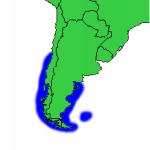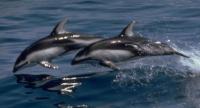 |
|
Genus Lagenorhynchus
The species of the genus Lagenorhynchus, collectively known in colloquial parlance as lags, are dolphins without prominent beaks located in the worlds temperate and subpolar waters. Each species is identifiable by its unique coloration, and they each have several common names, often related to the color pattern. The name Lagenorhynchus means "flask-beaked," and individuals of this genus are sometimes called "plowshare-headed dolphins." | ||||
 Distribution Map
Distribution Map(Click for larger version) |
The white-beaked dolphin is found in the cold temperate and subarctic waters of the northern North Atlantic and the Baltic Sea, south to Cape Cod and Portugal. The name albirostris means "white beak," although, ironically, the beak is not always white. White-beaked dolphins are identifiable by the light area on the back behind the dorsal fin. The back is dark gray, marked with a pattern of chevrons, stripes, or blazes. Depending on the stock, the throat and belly may also be white. Groups are usually of approximately 10-20 individuals, although they sometimes number in the thousands. Although the white-beaked dolphin is not well-known as a bow-rider, it is sometimes attracted to boats. It sometimes engages in various acrobatics, such as spinning on its long axis while jumping and swimming on its side. Breaching is also very frequent. | ||||
 Distribution Map
Distribution Map(Click for larger version) |
The Atlantic white-sided dolphin occupies the nothern North Atlantic temperate and subpolar waters, in much the same area as the aforementioned white-beaked dolphin. It can be differentiated from the white-beaked dolphin by the presence of a "flash," a striking orange-yellow spot behind the dorsal fin, easily visible when the dolphin leaps from the water. In addition, it has far more distinct keels and a thicker tail stock than the white-beaked dolphin. Like the white-beaked dolphin, it is fast, acrobatic, and breaches frequently, although not to quite as great an extent. | ||||
 Distribution Map
Distribution Map(Click for larger version) |
Peale's dolphin has a very limited distribution, found only along the coasts of southern South America and the Falkland Islands. In appearance it bears a resemblance to the Pacific white-sided dolphin, with a white patch on the foreward part of each side and a prominant grayish streak on the caudal end of each side. Although it is known to be somewhat acrobatic, it is usually a rather slow swimmer, unlike the other members of the genus. Groups are generally small near coastal areas, with many being fewer than ten individuals. In the open ocean, they may reach 2,000 dolphins. | ||||
 Distribution Map
Distribution Map(Click for larger version) |
The hourglass dolphin may be found in the Southern Hemisphere, roughly between the 45th and 65th parallels. Rarely are specimens seen near land, as it is a very pelagic species. The name comes from a prominent hourglass pigmentation on its flanks defined by two white areas and two black areas meeting at a point This coloration makes it easily identifiable. It is also very rare, with five museum individuals being the only source for information as of 1974. It is a fast swimmer, known to ride the bow waves and stern wakes of ships. Sometimes groups are seen with other pelagic species, such as various rorqual whales, beaked whales, and blackfish. | ||||
 Distribution Map
Distribution Map(Click for larger version) |
The Pacific white-sided dolphin is endemic to the northern Pacific Ocean, from the southern tip of Baja California in the west, north to the Aleutian Islands, and south to northern Taiwan in the east. It stays south of the Arctic currents. It has a black dorsal side which blends into a light-colored patch on the forward half of each flank. The ventral side is white, except for the caudal end. Like the other members of this genus, it is very acrobatic, performing breaches, spinning, bow-riding, and porpoising. It is also very inquisitive, not fearing the approach of humans. Schools are very large, some being 2.5 kilometers across and 16 kilometers long. It also likes to associate with other marine mammals, such as humpback whales, Risso's dolphins, and seals. | ||||
 Distribution Map
Distribution Map(Click for larger version) |
The dusky dolphin is found only in the Southern Hemisphere's temperate and cold temperate waters, near South America, parts of Africa, and New Zealand. Its scientific name obscurus refers to its indistinct coloration. The black and white areas on its body tend to blend together, without the sharp demarcation that occurs in many other species. The dorsal fin has a unique bicolor pigmentation, with a light crescent on the trailing half that may vary from individual to individual. It is one of the most acrobatic of dolphins, as wild specimens frequently do somersaults and spin on their long axes while jumping. They are quite gregarious, and allow humans to interact with them. Their intelligence is also quite remarkable, as their brain size and weight is similar to that of humans. | ||||
|
BibliographyBaker, Mary L. Whales, Dolphins, and Porpoises of the World. New York: Doubleday & Company, Inc., 1987. Carwardine, Mark. Eyewitness Handbooks: Whales, Dolphins, and Porpoises. New York: Dorling Kindersley Ltd., 1995. Ellis, Richard. Dolphins and Porpoises. New York: Alfred & Knopf, Inc., 1982. Klinowska, Margaret. Dolphins, Porpoises, and Whales of the World: The IUCN Red Data Book. Gland, Switzerland: World Conservation Union, 1991. |
|
© 1998 Thinkquest Team 17963 <17963@advanced.org Modified: 29 August 1998, Created: 7 August 1998 |

 Leaping Pacific White-sided Dolphins
Leaping Pacific White-sided Dolphins